|
|
Post by irishjack on Nov 20, 2014 22:17:31 GMT
This arrived today it was with a lot of 2 other covers, eBay seller used a cell phone photo was blurry and not much bigger then a thumbnail  I threw a 5 buck bid as a gamble
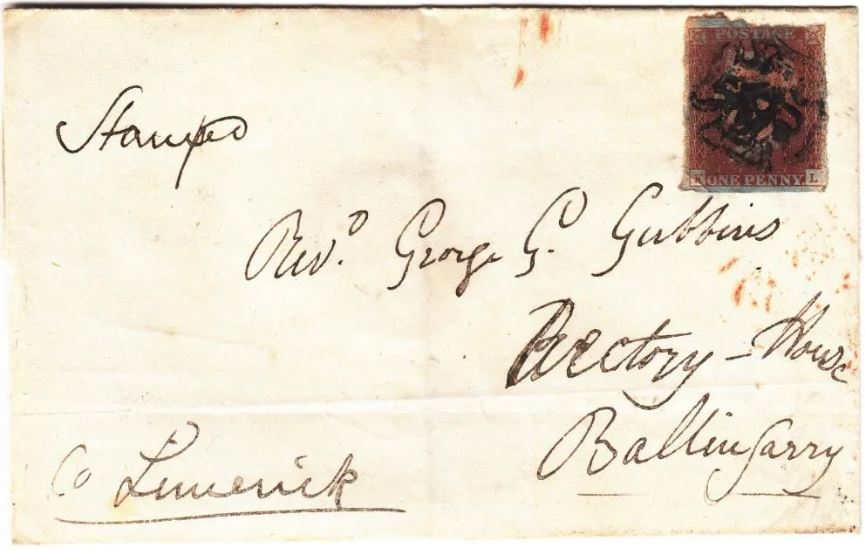
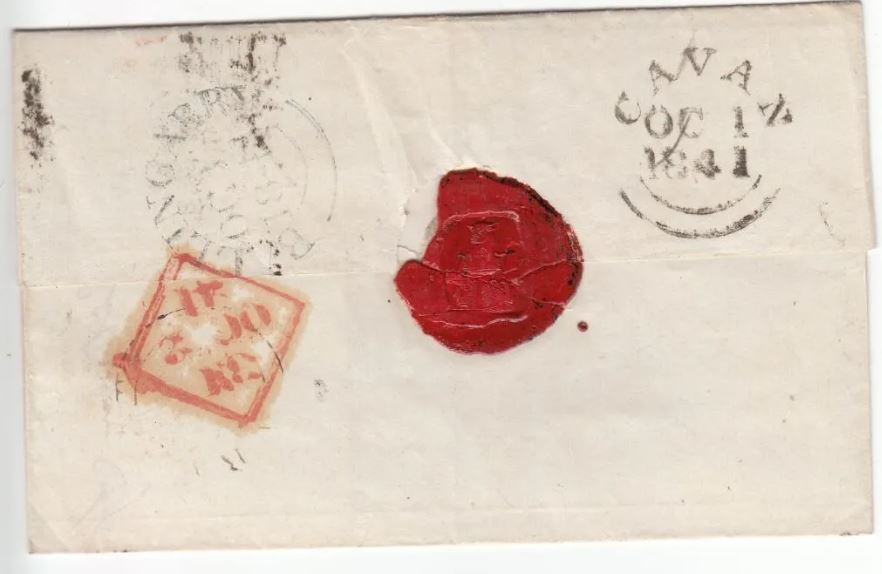
Having trouble making out the date on the Ballingarry cancel I leaning on a 8 or 3 Here is retroreveal image
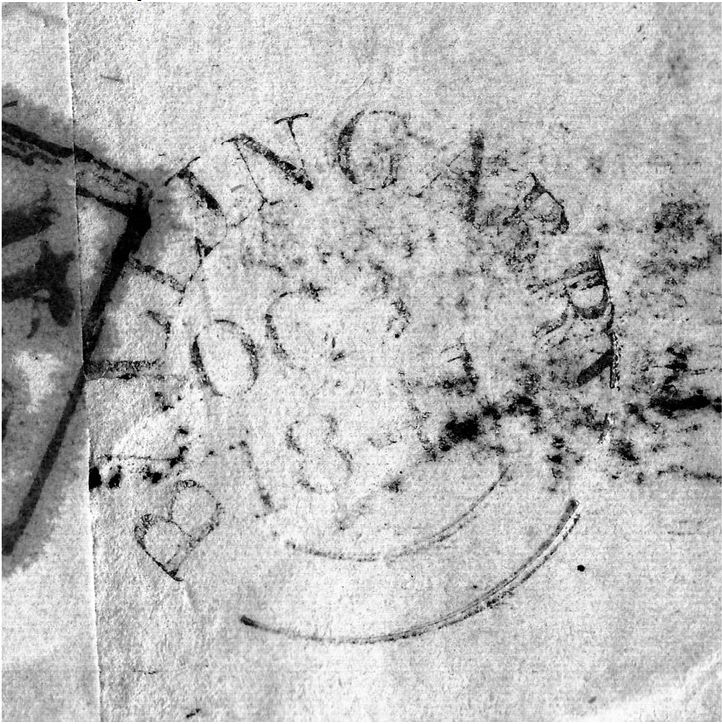
As always if the MX is not tied to the cover there will always be questions. the back of the cover does have a Cavan Cancel ( could this be a in transit cancel ? ). At the time Ballingarry had a vital weaving and linen industry until the Great Famine in 1845 so plenty of mail would have been sent there.
This is addressed to the Rectory House, My quest continues. Can anyone make out the name of the person it was sent to Is it Rev George. G Gibbons or Gibbins?
|
|
|
|
Post by irishjack on Nov 20, 2014 22:52:57 GMT
Here is a 1200dpi of the seal
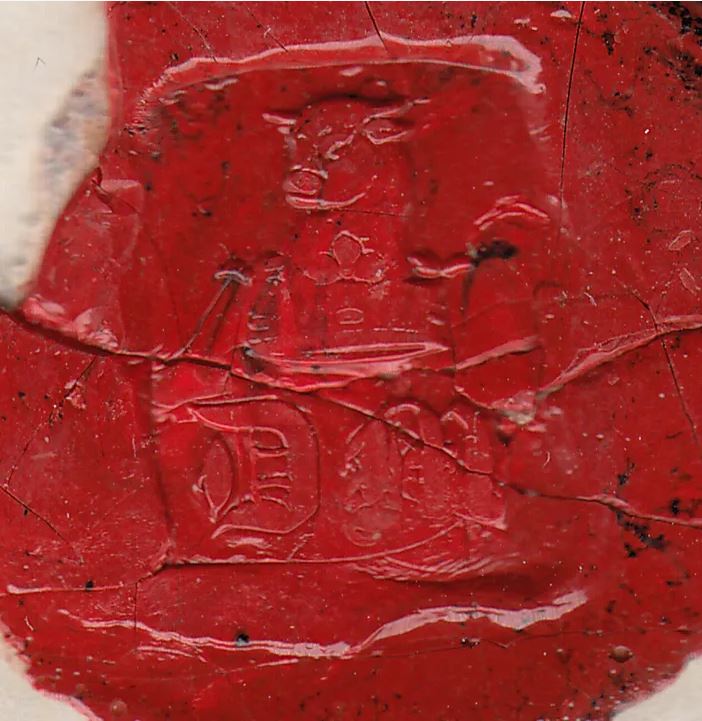
|
|
|
|
Post by stoltzpup on Nov 20, 2014 23:21:01 GMT
Name George G. GUBBINS
Born 10 Mar 1810 Knocklong, Limerick, Ireland
Gender Male
Died 12 Mar 1881 Chicago, Cook County, IL
Revd George Gough Gubbins, Vicar of Ballingarry
|
|
|
|
Post by irishjack on Nov 20, 2014 23:47:29 GMT
Name George G. GUBBINS Born 10 Mar 1810 Knocklong, Limerick, Ireland Gender Male Died 12 Mar 1881 Chicago, Cook County, IL Revd George Gough Gubbins, Vicar of Ballingarry Thanks Bud, |
|
|
|
Post by irishjack on Nov 21, 2014 0:12:42 GMT
With Buds help I did a little digging. It seems that after leaving Ireland and landing in the States he might have became a police officer? genforum.genealogy.com/cgi-bin/pageload.cgi?jane,o,farrell::gubbins::33.html I emailed the poster for a copy of the photo, but that post was 14 years ago and the email might not be active Fingers crossed
Email bounced back  |
|
rod222
Member 
Posts: 11,044  What I collect: Worldwide Stamps, Ephemera and Catalogues
What I collect: Worldwide Stamps, Ephemera and Catalogues
|
Post by rod222 on Nov 21, 2014 2:56:47 GMT
I'd say October 3rd, it is only 204 Km (127 miles) 2-3 days would fit.
Also the Cavan Postmark would fit, not as a transit mark.
The red square Pmk, may be a Dublin receiving mark, so the cover would have dog-legged, that route would make sense.
The daughter of Rev Gubbins (Louisa Mary) appears to have married a Rector from Toronto Canada
this appeared in the Cavan Newspaper.
Did you buy the cover from Canada?
|
|
Admin
Administrator 
Posts: 2,676
|
Post by Admin on Nov 21, 2014 3:36:42 GMT
A eBay seller from England Rod. Looks like the postmaster had no scissors on hand and torn with a ruler/straight edge. |
|
BC
Departed
Rest in Peace
Vancouver, BC Canada
Posts: 836  What I collect: Worldwide USED up to the 1960's, later years from countries that came into existence after then, like Anguilla, Tuvalu and Transnistria.
What I collect: Worldwide USED up to the 1960's, later years from countries that came into existence after then, like Anguilla, Tuvalu and Transnistria.
|
Post by BC on Nov 21, 2014 3:40:50 GMT
Good pick Jack. A cover that old is worth way more than $5 in historical value alone.
|
|
rod222
Member 
Posts: 11,044  What I collect: Worldwide Stamps, Ephemera and Catalogues
What I collect: Worldwide Stamps, Ephemera and Catalogues
|
Post by rod222 on Nov 21, 2014 3:43:28 GMT
Right, I can now see the diamond in the middle of the cross.
I had thought perhaps you may have a rare "sub office" cross, because it looked so weird.
"The volume of mail generated in Ireland in the 1840's was relatively small"
"Distinctive Irish Maltese Crosses are difficult to obtain on cover"
Looks like you have a "proving" cover for the Cavan Maltese Cross,
this may / may not be an article of high interest to the specialists.
Nice item indeed.
PS: Records show large family members in the census of Gubbins of Cavan 1758 onwards
The "Stamped" handwritten on the cover is curious, I wonder the reason behind that.
|
|
Admin
Administrator 
Posts: 2,676
|
Post by Admin on Nov 21, 2014 5:08:30 GMT
rod222 After having a ponder on this I have come up with a couple of possibility's. If the sender say was another victor they would send out a lot of letters to members of their congregation. When I was a kid growing up in Ireland (late 70's - early 80's) the local priest would come to the local school and hand deliver the letters addressed to the children's parents, he would also walk around the village and pop then in the letter box. This was common practise to save on postage. With being 1841 a penny was a considerable amount, if they had say 240 houses in their parish that's a Pound which would be a lot of money. They probably did the same practise of hand delivery for the local mail back then. Back then stamps were a new thing, maybe who ever wrote the address also wrote stamped so that letter would receive a stamp? and go in the postal system. After looking up the name Gubbins there is a lot of them also in Limerick It appears that the Gerge gubbins on the letter aurthured the history of the gubbins in Ireland. www.limerickcity.ie/media/limerick%20families%20112.pdf Stamp collecting sure can take you on a journey 
|
|
rod222
Member 
Posts: 11,044  What I collect: Worldwide Stamps, Ephemera and Catalogues
What I collect: Worldwide Stamps, Ephemera and Catalogues
|
Post by rod222 on Nov 21, 2014 7:33:45 GMT
There exists a variety of Maltese Cross from Alexandria in Scotland,
referred to as "Watery-inked Maltese Cross"
ID'd as watery appearance resulting in filling of the middle cross.
Yours shows similar characteristics, maybe an indication of cancelling ink used by both Offices.
|
|
rod222
Member 
Posts: 11,044  What I collect: Worldwide Stamps, Ephemera and Catalogues
What I collect: Worldwide Stamps, Ephemera and Catalogues
|
Post by rod222 on Nov 21, 2014 7:41:40 GMT
Random thought bubble..........
The wax seal is rather lovely, looks to me like "D.M" perhaps
I wonder if the Initials, married to the icon of what looks like a cow / bull, would indicate the seal was from a family named "Dexter" (Irish Cattle)
|
|
I.L.S.
Departed
Rest in Peace
I am in Clearfield, Pa. I love US Classic covers!
Posts: 2,113 
|
Post by I.L.S. on Nov 21, 2014 14:01:08 GMT
What a gorgeous cover! Well done!
|
|
|
|
Post by irishjack on Nov 21, 2014 19:48:30 GMT
rod222
The following is text is taken from
The Postmarks of Great Britain and Ireland, Part II. Section E(1) FIRST SUPPLEMENT
The Maltese Cross Cancellations By R. C. Alcock & F. C. Holland
A Post Office Circular of 25th April, I 84U, signed by Col. Maberly, was sent to all Postmasters and Sub-Postmasters stating: —
“It has been decided that Postage Stamps are to be brought into use forthwith, and as it will be necessary that every such Stamp should be cancelled at the Post Office, or Sub-Post Office, where the Letter bearing the same may be posted, I herewith forward for your use an Obliterating Stamp, with which you will efface the Postage Stamp upon every Letter despatched from your Office. RED COMPOSITION must be used for this purpose, and I annex directions for making it, with an impression of the Stamp.
“As the Stamps will come into operation by the 6th MAY, I must desire you will not fail to provide yourself with the necessary supply of Red Composition by that time.”
The specimen impression appeared at the bottom left of the circular, and between the notice quoted above and Col. Maberly’s signature was the recipe for making the “ Red Stamping Ink.” This recipe showed that the ingredients were to be:
1 lb. Printer’s red ink 1 pint Linseed oil:
Half-pint of the droppings of Sweet Oil
and directions were given that these ingredients were to be well mixed.
Would it not make since when they switched over to Black Ink for the cancel they would have had a similar recipe for making the ink? The postmaster may not have followed the instructions and the ink would become watery.
Also with ink temperature would have a factor in the viscosity of the liquid ink, the warmer the temperature the more watery it would be. The date is October the weather is normally damp and cold in Cavan that time of year, so they would have a fire for heat. I would think the person doing the cancels would have his or her work station close to the source of the heat.
|
|
rod222
Member 
Posts: 11,044  What I collect: Worldwide Stamps, Ephemera and Catalogues
What I collect: Worldwide Stamps, Ephemera and Catalogues
|
Post by rod222 on Nov 21, 2014 23:28:54 GMT
Thanks Jack, I had lost my recipe for cancellation ink.
In my opinion, your text contradicts the examples.
Your hypothesis is good, but the result would explain a differing recipe.
It has been my experience with the linseed oil strikes, the ink tends to separate on/in the paper,
and when the recipe wasn't adhered to, some ghastly results were evidenced.
My thoughts were that the ink had been "watered down", with water, but the flaw in that, is that few MC's are seen smudged.
If I come across any commentary on the ink, I'll pass it on.
|
|
rod222
Member 
Posts: 11,044  What I collect: Worldwide Stamps, Ephemera and Catalogues
What I collect: Worldwide Stamps, Ephemera and Catalogues
|
Post by rod222 on Nov 21, 2014 23:34:08 GMT
Jack here is a great link I have found, cancellation ink included. This would point to your Cavan MC being the first issued London MC perhaps. (It also agrees with you, regarding "dampness" of the ink  ) philatelics.org/~allan/shrop/mx/ireland.html |
|
|
|
Post by irishjack on Nov 22, 2014 0:15:42 GMT
rod222 The water down does make sense, the more I look it seems after placing the cancel into the ink pad, the ink pooled to the center (diamond), thus causing the smudge. The outer lines of the cancel look much dryer then the center.
Rod can the cancelation ink be water down with regular water (H2O)? with the amount of Sweet Oil and linseed oil would it not just separate?
I agree it looks like the Cavan MX was from the first London issue. |
|
rod222
Member 
Posts: 11,044  What I collect: Worldwide Stamps, Ephemera and Catalogues
What I collect: Worldwide Stamps, Ephemera and Catalogues
|
Post by rod222 on Nov 22, 2014 1:40:55 GMT
I don't know Jack, I would assume not. Remember these were very early days, perhaps the Postmaster used a water based recipe. It seems to me, when the Linseed was mixed above the recipe, Postmarks tended to bleed (as shown in your red Dublin receivers mark) Here are a few more, I have seen really bad cases, but cannot locate them in my database. You can see (what I assume the Linseed bleeding, forming a "halo" effect ) The Linseed was only used as a vehicle for the pigment to run fluently (guess) More reading ............................... Variations in obliterating Ink (see part 2) www.gbps.org.uk/displays/maltese-cross/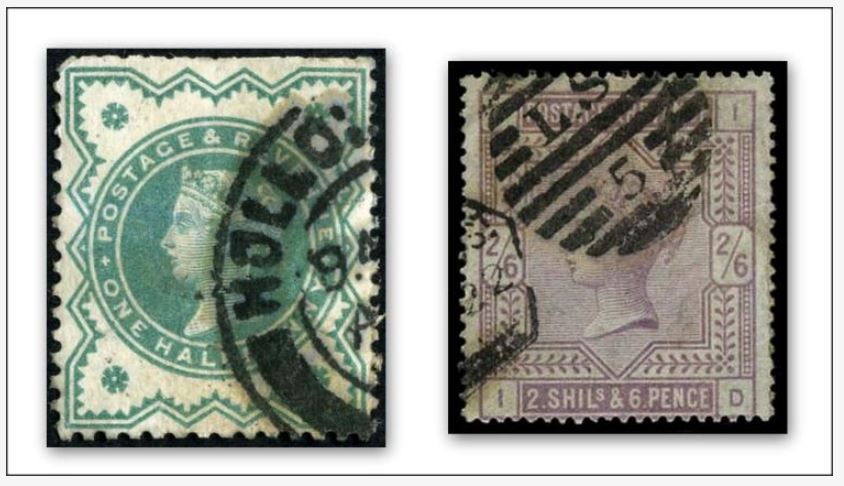 |
|
rod222
Member 
Posts: 11,044  What I collect: Worldwide Stamps, Ephemera and Catalogues
What I collect: Worldwide Stamps, Ephemera and Catalogues
|
Post by rod222 on Nov 22, 2014 1:51:49 GMT
Sorry Jack. You have to be a member to access the information. 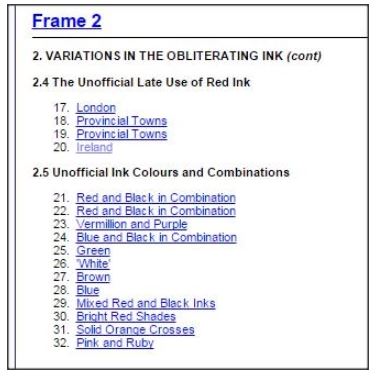 |
|
BC
Departed
Rest in Peace
Vancouver, BC Canada
Posts: 836  What I collect: Worldwide USED up to the 1960's, later years from countries that came into existence after then, like Anguilla, Tuvalu and Transnistria.
What I collect: Worldwide USED up to the 1960's, later years from countries that came into existence after then, like Anguilla, Tuvalu and Transnistria.
|
Post by BC on Nov 22, 2014 2:48:13 GMT
Phorensic Philately! This is great stuff guys!  |
|
Admin
Administrator 
Posts: 2,676
|
Post by Admin on Nov 22, 2014 4:34:53 GMT
Phorensic Philately! This is great stuff guys!  Never a dull moment bc  Well I did a bit of digging found this Here is a link to the site about the Gatehouse MX cancel www.gatehouse-folk.org.uk/detailpage.asp?d=42&ID=14It appears that that cancel suffered wear and tear during its life. Cavan post office was a busy one compared to other post offices in Ireland at the time. According to Cavan¹s postal history By Mairead Reynolds www.irishidentity.com/extras/heritage/stories/postal.htmLooking the cancel on the cover it appears that the innear cross and Diamond might be suffering from wear. Looking at the below image the diamond is very lightly inked. 1 reason could be wear. 2 the postmaster was heavy handed and the ink was squeezed out. Sorry if I confuse any newer members but Irishjack is also Me. I just forget to logout and re-log |
|
I.L.S.
Departed
Rest in Peace
I am in Clearfield, Pa. I love US Classic covers!
Posts: 2,113 
|
Post by I.L.S. on Nov 22, 2014 11:07:12 GMT
Thanks Jack, I had lost my recipe for cancellation ink. In my opinion, your text contradicts the examples. Your hypothesis is good, but the result would explain a differing recipe. It has been my experience with the linseed oil strikes, the ink tends to separate on/in the paper, and when the recipe wasn't adhered to, some ghastly results were evidenced. My thoughts were that the ink had been "watered down", with water, but the flaw in that, is that few MC's are seen smudged. If I come across any commentary on the ink, I'll pass it on. Here is something interesting on the subject if you will? An Excerpt from The Postage and Telegraph Stamps of Great Britain: - books.google.com/books?id=HJQIAAAAQAAJ&pg=PA45&lpg=PA45&dq=Half-pint+of+the+droppings+of+Sweet+Oil?&source=bl&ots=mUviuUmGyC&sig=E5zEMMFG_XecwvqOQNDkZMcL5hM&hl=en&sa=X&ei=r21wVO-zEIK_sQS3tYKQBQ&ved=0CCAQ6AEwAQ#v=onepage&q=Half-pint%20of%20the%20droppings%20of%20Sweet%20Oil%3F&f=false |
|
Admin
Administrator 
Posts: 2,676
|
Post by Admin on Nov 22, 2014 19:25:03 GMT
Nice link @i.L.S. I have it saved and will read it in full, but I did spend 1/2 hour glancing over it.
The recipe for the red ink 1 lb. Printer’s red ink 1 pint Linseed oil, Half-pint of the droppings of Sweet Oil. We have to also add in another factor human error, just how precise was the person responsible for making the concoction. How good was the quality of the ingredients from the vendor, in those days quality control and shelf life of materials were in their infancy.
How well was it mixed. I know from working with paints and piqments they need to be regularly mixed, sitting on a shelf the ingredients will separate.
When They switched over to the Black ink it was a printers ink that was diluted, what it was diluted with? I have yet to find out.
I think I can rule out water. If water was used we would have reports of the cancels being damaged in soaking the stamps.
Watering down could mean using a liquid similar to the density of water such as alcohol or mineral sprits.
These would be common and be with in reach to the postmaster. I also think that alcohol or minerals oils would blend in with the printers ink.
If the postmaster was near the end of his batch of ink and having to wait a number of days for a new order he might take it in his own hands to stretch out his remaining ink. Remember there was no overnight or same day delivery as we know it.
Another possibility is that October 1 1841 was a Friday. Fridays afternoons have always been a time to clean up the office and get things sorted out for the following week.
Lets say after a week of being in use the Hand Canceller would have a weeks worth of ink build up, maybe the postmaster in Cavan decided to clean up his tool with some type of solvent to remove the ink build up. During this action in comes the person with the letter, while the tool still has solvent on it places it in the ink pad and strikes the stamp.
This would explain the ink being watery.
We will never know.
|
|